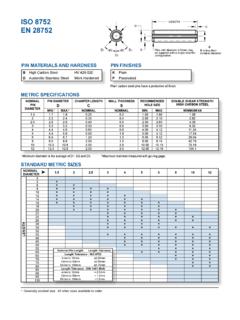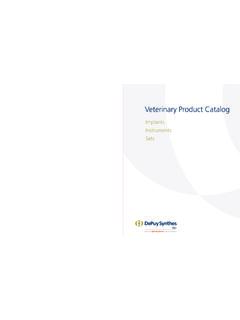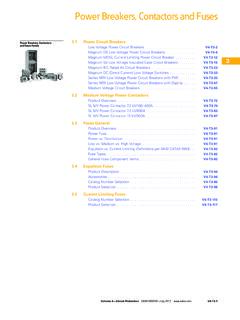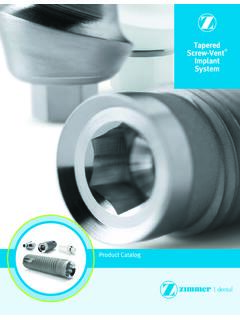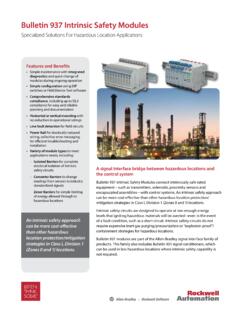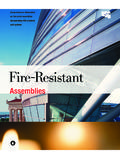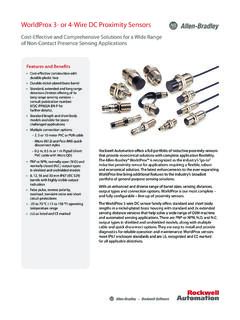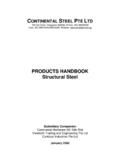Transcription of INSERTS FOR PLASTICS
1 LF = F x L INSERTS FOR PLASTICSP lasticInsertBoltFriction ForceForceLTo rqueF x LAxial Load(Tension)To rque = Coefficient of Friction =To rque x Bolt WHY INSERTS ? INSERTS provide reusable threads and secure tight threaded additional benefit is high load carrying LOAD CARRYINGThe load carrying ability of the joint is enhanced by the larger diameter of the Insert as compared to the screw. INSERTS are generally twice the diameter of the screw and that increases the shear surface fourfold. Pull-out resistance can further be enhanced by increased Insert BYSTRESS RELAXATIONA common problem with bolted joints in plastic applications is that plastic is susceptible to creep or stress relaxation.
2 Under loads well below the elastic limit, PLASTICS will lose their ability to maintain a load. When this occurs, the threaded connection becomes loose. The brass and aluminum thread provides permanent creep resistance for the entire load path of the OF THE THREADED JOINTThe primary benefit for using an Insert is that it preserves the threaded joint integrity for the life of the application. An additional benefit is the unlimited reusable SEATING TORQUED uring the assembly process with a mating component, the screw has to be tightened with sufficient torque to introduce the recommended axial tension in order to achieve the required load between the screw and Insert threads to prevent loosening.
3 The larger body diameter and body design of the Insert allow the appropriate installation torque to be applied to the SUPPORTS ince SPIROL s inception in 1948, we have lead the industry in application engineering support for fastening, joining and assembly. Our INSERTS are designed to maximize and balance tensile (pull-out) and rotational torque performance. Our Application Engineers have the technical know-how and experience to work together with our customers to develop a cost-effective solution to meet the application PRODUCTRANGE/CAPABILITYOur leading edge production technology is suitable to meet all your specific needs for both long and short run requirements at competitive pricing.
4 We offer a broad range of standard products and cost-effective methods of producing special comprehensive quality concept encompasses not only product quality, but also quality of design and service. Process control, operational discipline and continuous improvement are the foundation of our mission to exceed our customers' expectations. We are IATF 16949, ISO 9001 and ISO 14001 SUPPORTWe offer installation technical support and installation equipment. Our standardized, time-tested, modular designs are robust, reliable and easily adjustable allowing simple customization to meet the specific needs of an SPIROL INSERTS ?LOCAL DESIGN, GLOBAL SUPPLY SPIROL has Application Engineers throughout the world to assist you in your designs, supported by state-of-the-art manufacturing centers and worldwide stocking facilities to simplify the logistics of delivering your DESIGND iamondStraightHelicalTypes of KnurlsPOST-MOLD INSTALLED WITH HEAT OR ULTRASONIC INSTALLATION Knurls are used to increase resistance to torque.
5 Straight knurls, as opposed to diamond knurls, are the preferred design. Coarser knurls increase resistance to torque but they also induce greater stress on the plastic. In addition, the circumference of the Insert determines the knurl pitch so there are practical limitations on knurl design. Helical knurls, in comparison to straight knurls, lower torque resistance but increase axial pull-out resistance. In practice, knurl angles between 30 and 45 degrees have a positive impact on pull-out resistance with a minimal loss of torque value. Several knurl bands with different helix angles can be combined on the same Insert to achieve an optimum combination of torque and pull-out objective is to design an Insert with sufficient torque resistance to accommodate the tightening torque necessary to achieve sufficient axial tension load on the threaded joint to keep it together and prevent loosening, while also achieving pull-out values necessary for the load conditions that the Insert will be exposed to while in general, resistance to torque is a function of diameter and resistance to pull-out is a function of length.
6 These functions, however, are interactive and the challenge for the designer is to achieve the optimum combination of both. Some INSERTS are designed with a slightly larger diameter knurl band between two slightly smaller diameter knurl bands on either side, separated from the larger knurl band by grooves. With a properly designed Insert installed in a hole manufactured as recommended, the plastic will flow over the larger knurl band into the groove and knurls behind the larger knurl band in the opposite direction of installation, significantly increasing pull-out resistance. All the plastic above the larger knurl band in effect becomes a shear plane. A head facilitates plastic flow into the upper grooves of the for best performance, it is essential that the Insert is properly aligned with the hole during installation.
7 This can be facilitated with tapering the Insert or by providing a pilot. Pilots need to be of sufficient length and have a plain, unknurled diameter the same size or slightly smaller than the 1. Proper Plastic FlowFigure 2. Improper Plastic FlowDETERMINING PROPER INSTALLATION Retention within the hole is provided by the plastic conforming to the external features of the Insert. A sufficient volume of plastic must be displaced to entirely fill these external features so that the Insert achieves maximum performance when the plastic solidifies. An accurate way of determining sufficient plastic flow into the knurls, barbs and undercuts of the Insert is to take a cross section of the installed Insert and ensure that the features are mirrored in the plastic as shown in Figures 1 and 2.
8 It is extremely important to ensure proper plastic flow into the features of the Insert as this dictates the torque and pull-out performance. In Figure 2, the plastic did not sufficiently flow into the retention features, which will result in low Insert OF KNURLS3 PRESS-IN INSERTST hese INSERTS are designed to reduce installation cost at a sacrifice of torque and pull-out knurls are used to provide both torque and pull-out resistance and to ensure good plastic flow as the Insert rotates into the hole. Installation torque to achieve sufficient tension between the threads is not a problem in that the helical knurls are designed so that the direction of the installation torque will have the tendency to drive the Insert into the hole which of course is not possible as the threaded joint is pilot only slightly smaller than the hole and of sufficient length is designed to assure straight insertion into the hole.
9 MOLDED-IN INSERTSThis process, although generally more costly in getting the Insert into place than the post-mold installation process, provides the best length and diameter have an impact on pull-out resistance and torque. The challenge is to find the most cost-effective solution that provides/meets the installation torque requirements to achieve a good threaded joint, and the pull-out values that meet the application load knurls are the designer s choice to maximize the torque resistance for a given diameter. The volume of these knurls must be such that sufficient plastic is encapsulated in the voids to meet the installation torque requirements for the given amount of plastic trapped in the undercuts of the Insert must be sufficient to achieve the pull-out resistance to which the Insert is subjected while in service.
10 In order to facilitate insertion into the mold squarely on the core pin, the tolerance of the minor thread diameter is reduced for a good fit between the Insert and these mold core pins. Countersinks are designed to simplify the placing of the Insert on the INSERTS provide an additional alternative to prevent plastic from flowing into the inside of the INSERTS Provide the best pull-out resistance for a post-mold installed Insert. The threads are designed with a thin profile to minimize inducing stress into the plastic and a relative coarse pitch to provide the maximum plastic shear surface to resist torque is not a problem in that tightening increases the friction between the plastic and threads, and the larger diameter of the external Insert thread increases the frictional surface.
